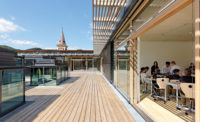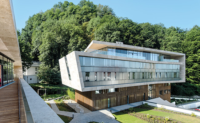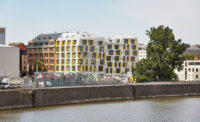Lustenau, Austria
Can an office building, using only heat generated by occupants, their equipment, and lighting—and using only operable panels for cooling—maintain year-round indoor comfort? This proposition has long intrigued Dietmar Eberle, architect, sustainable-building pioneer, and professor at the ETH Zürich.
The building’s numerical name refers to 22 to 26 degrees Celsius (72 to 79 degrees Fahrenheit), a widely accepted measure of interior comfort. The structure maintains an average temperature of 23 degrees Celsius year-round without heating or air-conditioning systems. It is unique, Eberle emphasizes, and he does “not know of any other attempts, precedents, or similar contemporary buildings with this theme.”
Hailing from Voralberg, Eberle established his first office there almost three decades ago. Baumschlager Eberle’s energy-efficient buildings first appeared in the 1990s, displaying transparent, intelligent facades. Although the firm has designed massive structures and explored building automation and passive strategies, 2226 marks a new direction.
On a recent visit, during a rainstorm that followed a heat wave, 2226’s indoor air was fresh and pleasing. Occupants report that the interiors remained surprisingly comfortable in winter (“We thought we would need electrical heaters,” one joked). The interiors are bright and elegant, with fine lime plaster on the walls, oiled silver fir window frames, and light-toned, float-finished polished-concrete floors. Baumschlager Eberle’s employees work on the second and third floors, while other companies, such as architect Antonella Rupp and furniture manufacturer USM, are renting the top floors.
The square floor plan repeats on each of the six levels. Vertical-circulation and service areas are arranged in a pinwheel shape, dividing floors into four loftlike rooms, each with a double exposure. A café is on the ground floor.
But 2226’s signature feature is its elegantly proportioned, starkly simple, and finely detailed facade. Employing a construction method that is typical of Voralberg and the surrounding region, it consists of a double withe of two different structural terra-cotta blocks (the inner is load bearing, the outer a special insulating block) finished with lime plaster on the interior and exterior. Deeply recessed triple-glazed windows occupy 24 percent of the facade, which is three feet thick.
During the winter (January temperatures in Voralberg average 24 degrees Fahrenheit), the well-insulated, extremely airtight facade stores 22 percent of the heat gains from occupants, computers, lighting, and appliances. The interior walls and slabs hold onto 78 percent. These surfaces radiate heat throughout the day. The facade has a very low heat transfer and maintains a satisfying indoor climate throughout the night during the coldest months.
During the summer (July averages 74 degrees Fahrenheit), the panels open at night for passive cooling. Sensors close the panels when the indoor temperature is adequate. The facade’s low heat transfer retains the cold air and ensures comfortable conditions during working hours. Other passive features include deep-set windows that occupy a small percentage of the facade and are shaded by it in summer; the office floors’ 10-foot-high clearances, which increase the average cubic space per occupant and reduce CO2 concentrations; and the vertical panels, in a shape that was selected because it optimizes airflow into the rooms.
A software-driven system operates the window panels and RECORDs building performance data. Values for brightness, temperature, humidity, and CO2 levels appear on a tablet-sized screen installed on the rear wall of each room. Sensors located above each screen RECORD these variables, and a rooftop sensor tracks the outdoor temperature. Occupants can monitor the air quality, and a KNX BUS system (a building-management system used in Europe) collects data on a central facility server and controls the panels.
Because scant information exists about the thermal behavior of large buildings and how thermal inertia impacts a building’s temperature over long periods, 2226’s design relied on input from Lars Junghans, an engineer from the University of Michigan specializing in building optimization and automation. He created simulations to calculate the building’s heat losses, gains, and storage capacity during a 12-month cycle and developed the software for it. According to Junghans, 2226 “performs better than expected. The only unusual issue was the relatively low CO2 concentration in the building because of the lime plaster surfaces.”
For now, the air remains fresh because the slowly drying lime plaster absorbs CO2. When hardened, this process ceases, yet the plaster will regulate indoor humidity and inhibit mold. (On the exterior, the lime plaster, mixed with hemp, acts as a fungicide and will not crack with temperature changes.)
Like any prototype, 2226 has revealed shortcomings and produced unexpected results. Whereas the bulky facade conserves energy, it also reduces the amount of rentable square footage. And the expense incurred from using quality materials and skilled labor, although offset by the lack of mechanicals, renders the final cost of construction comparable to that of a conventional building. The building’s performance will be evaluated this summer.
Why aren’t more architects doing this? According to Eberle, clients are averse to unconventional ideas about energy-efficient buildings. (He is an investor on this project.) Building research has largely ignored the potential of both thermal inertia and how big buildings store and radiate heat, crucial information for this concept. One also senses that the unique reservoir of skilled labor and traditional materials available in Voralberg certainly lent inspiration to making this prototype.
Meanwhile, Dietmar Eberle continues to explore the possibilities of a building without mechanical systems—in a university tower in Luxembourg, to open this autumn, and in two apartment blocks in Voralberg modeled on 2226, currently in planning. “As a proposition,” he muses, “this can work throughout the world.”
People
Owner:
Architect:
Personnel in architect's firm who should receive special credit:
Lead Project Designer:
Project Team:
Engineer(s):
Mechanical, Electric, and Plumbing:
Consultant(s):
Lighting:
General contractor:
Photographer(s):
CAD system, project management, or other software used: Size: 34,500 square feet Construction cost: $4 million Completion date: April 2013 |
Products
Structural system
Manufacturer of any structural components unique to this project:
Exterior cladding
Masonry:
Precast concrete:
Wood:
Windows
Glazing
Doors
Interior finishes
Special interior finishes unique to this project:
Furnishings
Chairs:
Lighting
Conveyance
Energy |















Post a comment to this article
Report Abusive Comment